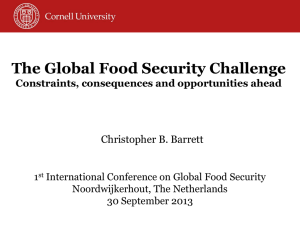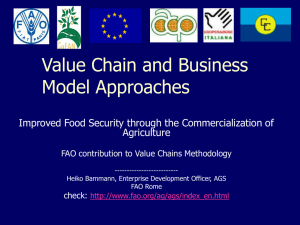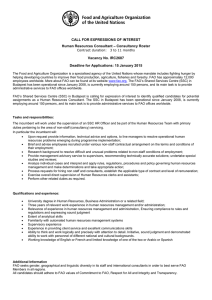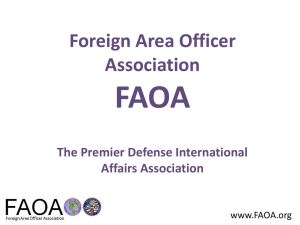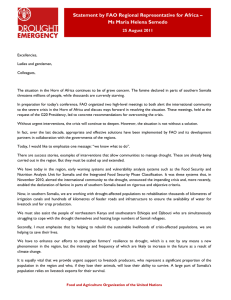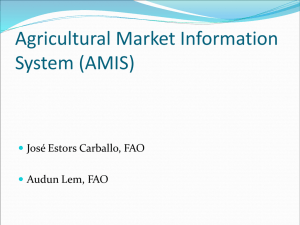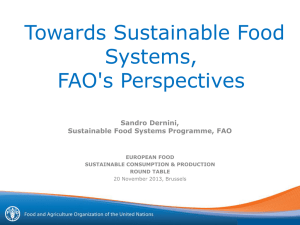Climate change - Food and Agriculture Organization of the United
advertisement
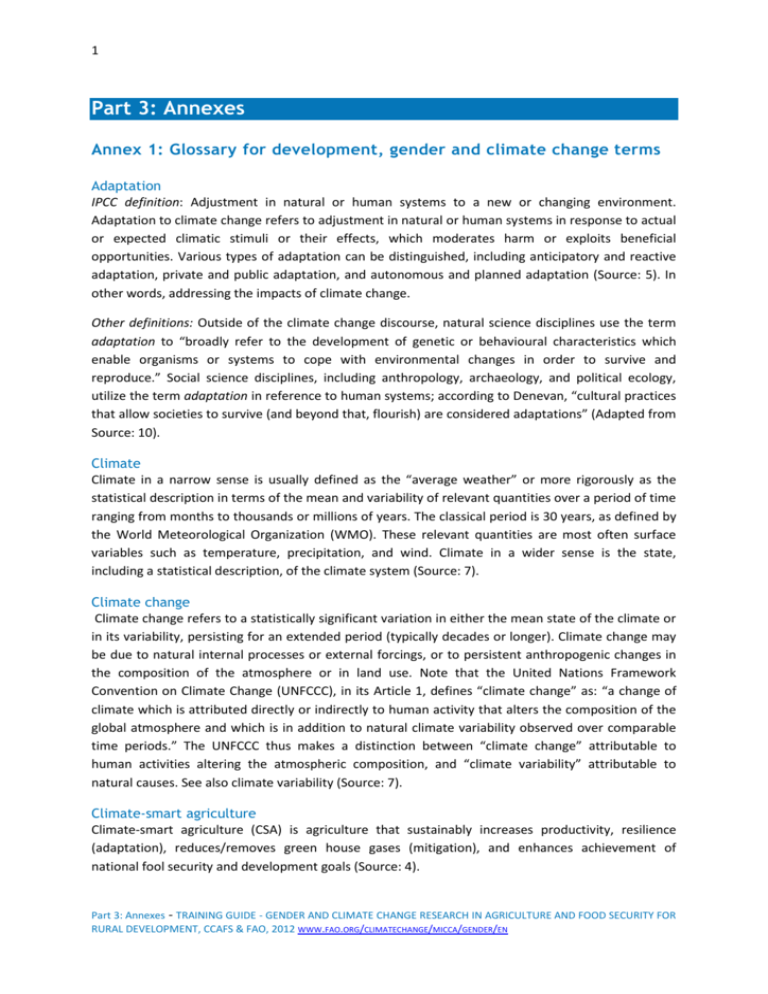
1 Part 3: Annexes Annex 1: Glossary for development, gender and climate change terms Adaptation IPCC definition: Adjustment in natural or human systems to a new or changing environment. Adaptation to climate change refers to adjustment in natural or human systems in response to actual or expected climatic stimuli or their effects, which moderates harm or exploits beneficial opportunities. Various types of adaptation can be distinguished, including anticipatory and reactive adaptation, private and public adaptation, and autonomous and planned adaptation (Source: 5). In other words, addressing the impacts of climate change. Other definitions: Outside of the climate change discourse, natural science disciplines use the term adaptation to “broadly refer to the development of genetic or behavioural characteristics which enable organisms or systems to cope with environmental changes in order to survive and reproduce.” Social science disciplines, including anthropology, archaeology, and political ecology, utilize the term adaptation in reference to human systems; according to Denevan, “cultural practices that allow societies to survive (and beyond that, flourish) are considered adaptations” (Adapted from Source: 10). Climate Climate in a narrow sense is usually defined as the “average weather” or more rigorously as the statistical description in terms of the mean and variability of relevant quantities over a period of time ranging from months to thousands or millions of years. The classical period is 30 years, as defined by the World Meteorological Organization (WMO). These relevant quantities are most often surface variables such as temperature, precipitation, and wind. Climate in a wider sense is the state, including a statistical description, of the climate system (Source: 7). Climate change Climate change refers to a statistically significant variation in either the mean state of the climate or in its variability, persisting for an extended period (typically decades or longer). Climate change may be due to natural internal processes or external forcings, or to persistent anthropogenic changes in the composition of the atmosphere or in land use. Note that the United Nations Framework Convention on Climate Change (UNFCCC), in its Article 1, defines “climate change” as: “a change of climate which is attributed directly or indirectly to human activity that alters the composition of the global atmosphere and which is in addition to natural climate variability observed over comparable time periods.” The UNFCCC thus makes a distinction between “climate change” attributable to human activities altering the atmospheric composition, and “climate variability” attributable to natural causes. See also climate variability (Source: 7). Climate-smart agriculture Climate-smart agriculture (CSA) is agriculture that sustainably increases productivity, resilience (adaptation), reduces/removes green house gases (mitigation), and enhances achievement of national fool security and development goals (Source: 4). Part 3: Annexes - TRAINING GUIDE - GENDER AND CLIMATE CHANGE RESEARCH IN AGRICULTURE AND FOOD SECURITY FOR RURAL DEVELOPMENT, CCAFS & FAO, 2012 WWW.FAO.ORG/CLIMATECHANGE/MICCA/GENDER/EN 2 Climate system The climate system is the highly complex system consisting of five major components: the atmosphere, the hydrosphere, the cryosphere, the land surface and the biosphere, and the interactions between them. The climate system evolves in time under the influence of its own internal dynamics and because of external forcings such as volcanic eruptions, solar variations, and human-induced forcings such as the changing composition of the atmosphere and land-use change (Source: 7). Climate variability Climate variability refers to variations in the mean state and other statistics (such as standard deviations, the occurrence of extremes, etc.) of the climate on all temporal and spatial scales beyond that of individual weather events. Variability may be due to natural internal processes within the climate system (internal variability), or to variations in natural or anthropogenic external forcing (external variability). See also climate change (Source: 7). Co-benefits IPCC definition: Co-benefits are the benefits of policies that are implemented for various reasons at the same time – including climate change mitigation – acknowledging that most policies designed to address greenhouse gas mitigation also have other, often at least equally important, rationales (e.g. related to objectives of development, sustainability, and equity). The term co-impact is also used in a more generic sense to cover both the positive and negatives sides of the benefits (Source: 5). Community based adaptation (CBA) Builds the resilience of communities and the ecosystems upon which they rely in the face of climate change impacts. CBA actions need to: (1) be community-driven; (2) be strategically-aligned with country programme strategies on climate change adaptation; (3) integrate livelihoods and natural resource management perspectives; in ways that take care of the natural resource base, while enhancing the resilience of resource-based livelihoods and contributing to global environmental benefits; (4) leverage lessons learned from community actions to inform national policy dialogues (Source: 6). Development Planned socio-cultural and economic change for the improvement of quality of living. The goal is to encourage change that is sustainable, equal and efficient (Source:: 17). Extreme weather event An extreme weather event is an event that is rare within its statistical reference distribution at a particular place. Definitions of ’rare’ vary, but an extreme weather event would normally be as rare as or rarer than the 10th or 90th percentile. By definition, the characteristics of what is called extreme weather may vary from place to place. An extreme climate event is an average of a number of weather events over a certain period of time, an average which is itself extreme (e.g., rainfall over a season) (Source: 7). Food insecurity A situation that exists when people lack secure access to sufficient amounts of safe and nutritious food for normal growth and development and an active and healthy life. It may be caused by the Part 3: Annexes - TRAINING GUIDE - GENDER AND CLIMATE CHANGE RESEARCH IN AGRICULTURE AND FOOD SECURITY FOR RURAL DEVELOPMENT, CCAFS & FAO, 2012 WWW.FAO.ORG/CLIMATECHANGE/MICCA/GENDER/EN 3 unavailability of food, insufficient purchasing power, inappropriate distribution, or inadequate use of food at the household level. Food insecurity may be chronic, seasonal, or transitory (Source: 7). Food security Food security exists when all people, at all times, have physical and economic access to sufficient, safe and nutritious food to meet their dietary needs and food preferences for an active and healthy life (Source: 14). Gender Gender refers not to male and female, but to masculine and feminine - that is, to qualities or characteristics that society ascribes to each sex. People are born female or male, but learn to be women and men. Perceptions of gender are deeply rooted, vary widely both within and between cultures, and change over time. But in all cultures, gender determines power and resources for females and males (Source: 2). Gender shapes the opportunities and constraints that women and men face in securing their livelihoods across all cultural, political, economic and environmental settings. Gender influences the roles and relationships of people throughout all their activities, including their labour and decisionmaking roles (Source: 1). Gender analysis The study of the different roles of women and men in order to understand what they do, what resources they have, and what their needs and priorities are (Source: 2). Gender balance The equal and active participation of women and men in all areas of decision-making, and in access to and control over resources and services. The United Nations considers gender balance fundamental to the achievement of equality, development and peace (Source: 2). Gender equality Equal participation of women and men in decision-making, equal ability to exercise their human rights, equal access to and control of resources and the benefits of development, and equal opportunities in employment and in all other aspects of their livelihoods (Source: 2). Gender equity Fairness and impartiality in the treatment of women and men in terms of rights, benefits, obligations and opportunities. By creating social relations in which neither of the sexes suffers discrimination, gender equity aims at improving gender relations and gender roles, and achieving gender equality. The essence of equity is not identical treatment - treatment may be equal or different, but should always be considered equivalent in terms of rights, benefits, obligations and opportunities (Source: 2). Gender mainstreaming The UN lead and globally recognized strategy for achieving gender equality. Gender mainstreaming is defined by the United Nations as the process of assessing the implications for women and men of any planned action in all areas and at all levels. That means making both the concerns and experiences of women and men an integral dimension of all agriculture and rural development efforts (Source: 2). Part 3: Annexes - TRAINING GUIDE - GENDER AND CLIMATE CHANGE RESEARCH IN AGRICULTURE AND FOOD SECURITY FOR RURAL DEVELOPMENT, CCAFS & FAO, 2012 WWW.FAO.ORG/CLIMATECHANGE/MICCA/GENDER/EN 4 Gender relations The ways in which a society defines rights, responsibilities and the identities of men and women in relation to one another (Source: 2). Gender roles Those behaviours, tasks and responsibilities that a society considers appropriate for men, women, boys and girls (Source: 2). Gender roles are: socially constructed; learned; dynamic (they change over time); multi-faceted (they differ within and between cultures) and influenced by class, age, caste, ethnicity and religion (Source: 1). Greenhouse effect Greenhouse gases effectively absorb infrared radiation, emitted by the Earth’s surface, by the atmosphere itself due to the same gases, and by clouds. Atmospheric radiation is emitted to all sides, including downward to the Earth’s surface. Thus greenhouse gases trap heat within the surfacetroposphere system. This is called the ’natural greenhouse effect’. Atmospheric radiation is strongly coupled to the temperature of the level at which it is emitted. In the troposphere, the temperature generally decreases with height. Effectively, infrared radiation emitted to space originates from an altitude with a temperature of, on average, -19°C, in balance with the net incoming solar radiation, whereas the Earth’s surface is kept at a much higher temperature of, on average, +14°C. An increase in the concentration of greenhouse gases leads to an increased infrared opacity of the atmosphere, and therefore to an effective radiation into space from a higher altitude at a lower temperature. This causes a radiative forcing, an imbalance that can only be compensated for by an increase of the temperature of the surface-troposphere system. This is the ’enhanced greenhouse effect’ (Source: 7). Greenhouse gas Greenhouse gases are those gaseous constituents of the atmosphere, both natural and anthropogenic, that absorb and emit radiation at specific wavelengths within the spectrum of infrared radiation emitted by the Earth’s surface, the atmosphere, and clouds. This property causes the greenhouse effect. Water vapour (H2O), carbon dioxide (CO2), nitrous oxide (N2O), methane (CH4), and ozone (O3) are the primary greenhouse gases in the Earth’s atmosphere. Moreover there are a number of entirely human-made greenhouse gases in the atmosphere, such as the halocarbons and other chlorine- and bromine-containing substances, dealt with under the Montreal Protocol. Besides CO2, N2O, and CH4, the Kyoto Protocol deals with the greenhouse gases sulphurhexafluoride (SF6), hydro-fluorocarbons (HFCs) and per-fluorocarbons (PFCs) (Source: 7). Climate Impacts Climate impacts are consequences of climate change on natural and human systems. Depending on the consideration of adaptation, one can distinguish between potential impacts and residual impacts. Potential impacts are all impacts that may occur given a projected change in climate, without considering adaptation. Residual impacts are the impacts of climate change that would occur after adaptation. (Source: 7). Indigenous peoples People whose ancestors inhabited a place or a country when persons from another culture or ethnic background arrived on the scene and dominated them through conquest, settlement, or other means and who today live more in conformity with their own social, economic, and cultural customs Part 3: Annexes - TRAINING GUIDE - GENDER AND CLIMATE CHANGE RESEARCH IN AGRICULTURE AND FOOD SECURITY FOR RURAL DEVELOPMENT, CCAFS & FAO, 2012 WWW.FAO.ORG/CLIMATECHANGE/MICCA/GENDER/EN 5 and traditions than those of the country of which they now form a part (also referred to as ’native’ ‘aboriginal’ or ’tribal’ peoples) (Source: 7). Intergovernmental Panel on Climate Change (IPCC) The IPCC is the leading international body for the assessment of climate change. It was established by the United Nations Environment Programme (UNEP) and the World Meteorological Organization (WMO) to provide the world with a clear scientific view on the current state of knowledge in climate change and its potential environmental and socio-economic impacts (Source: 12). Kyoto Protocol The Kyoto Protocol to the United Nations Framework Convention on Climate Change (UNFCCC) was adopted at the Third Session of the Conference of the Parties to the UNFCCC in 1997 in Kyoto, Japan. It contains legally binding commitments, in addition to those included in the UNFCCC. Countries included in Annex B of the Protocol (most countries in the Organization for Economic Cooperation and Development, and countries with economies in transition) agreed to reduce their anthropogenic greenhouse gas emissions (carbon dioxide, methane, nitrous oxide, hydro-fluorocarbons, perfluorocarbons, and sulphur-hexafluoride) by at least 5 percent below 1990 levels in the commitment period 2008 to 2012 (Source: 7). The Kyoto Protocol has been in force since February 2005. Mitigation IPCC definition: Mitigation is an anthropogenic intervention to reduce the sources or enhance the sinks of greenhouse gases (Source: 5). In other words, reducing the causes of climate change. Other definitions: Note that outside the climate change discourse, mitigation often has a different, almost opposite, meaning. In the context of disasters, mitigation means measures taken to limit the adverse impact of natural hazards and related environmental and technological disasters. Examples of mitigation are the retrofitting of buildings or the installation of flood-control dams, and specific legislation (Source: 8). In other words, in the context of climate change, the word mitigation refers to reducing the causes of climate change, while in other contexts, the word mitigation refers to reducing or lessening a negative outcome. Participatory Rural Appraisal (PRA) A process of gathering information about a community’s situation with an emphasis on building up the process of discussion, analysis and planning in the community. In addition to fact-finding, the goal is to facilitate learning and analysis by local women and men (Source: 1). Resilience IPCC definition: Resilience is the amount of change a system can undergo without changing state (Source: 5) Other definitions: Many disciplines use the term resilience, for example, a sociological definition is: The ability of groups or communities to cope with external stresses and disturbances as a result of social, political, and environmental change (Source 11). Please consult this source for additional definitions. Part 3: Annexes - TRAINING GUIDE - GENDER AND CLIMATE CHANGE RESEARCH IN AGRICULTURE AND FOOD SECURITY FOR RURAL DEVELOPMENT, CCAFS & FAO, 2012 WWW.FAO.ORG/CLIMATECHANGE/MICCA/GENDER/EN 6 Risk Risk combines the magnitude of the impact with the probability of its occurrence, and captures uncertainty in the underlying processes of climate change, exposure, sensitivity and adaptation (Source: 15). United Nations Framework Convention on Climate Change (UNFCCC) The Convention was adopted on 9 May 1992 in New York and signed at the 1992 Earth Summit in Rio de Janeiro by more than 150 countries and the European Community. Its ultimate objective is the “stabilization of greenhouse gas concentrations in the atmosphere at a level that would prevent dangerous anthropogenic interference with the climate system.” It contains commitments for all Parties. Under the Convention, Parties included in Annex I aim to return greenhouse gas emissions not controlled by the Montreal Protocol to 1990 levels by the year 2000. The Convention entered into force in March 1994. See also Kyoto Protocol and Conference of the Parties (COP) (Source: 7). Stakeholders IPCC definition: Person or entity holding grants, concessions, or any other type of value that would be affected by a particular action or policy (Source: 5). SEAGA definition: Stakeholders are all the different people and institutions, both insider and outsider, who stand to gain or lose, given a particular activity (Source: 9). Sustainable development Development that meets the needs of the present without compromising the ability of future generations to meet their own needs (Source: 7). Technology transfer The broad set of processes that cover the exchange of knowledge, money, and goods among different stakeholders that leads to the spreading of technology for adapting to or mitigating climate change. As a generic concept, the term is used to encompass both diffusion of technologies and technological cooperation across and within countries (Source: 7). Uncertainty An expression of the degree to which a value (e.g., the future state of the climate system) is unknown. Uncertainty can result from lack of information or from disagreement about what is known or even knowable. It may have many types of sources, from quantifiable errors in the data to ambiguously defined concepts or terminology, or uncertain projections of human behaviour. Uncertainty can therefore be represented by quantitative measures (e.g., a range of values calculated by various models) or by qualitative statements (e.g., reflecting the judgment of a team of experts). See Moss and Schneider (2000) (Source: 7). Values Worth, desirability, or utility based on individual preferences. The total value of any resource is the sum of the values of the different individuals involved in the use of the resource. The values, which are the foundation of the estimation of costs, are measured in terms of the willingness to pay (WTP) by individuals to receive the resource or by the willingness of individuals to accept payment (WTA) to part with the resource (Source: 7). Part 3: Annexes - TRAINING GUIDE - GENDER AND CLIMATE CHANGE RESEARCH IN AGRICULTURE AND FOOD SECURITY FOR RURAL DEVELOPMENT, CCAFS & FAO, 2012 WWW.FAO.ORG/CLIMATECHANGE/MICCA/GENDER/EN 7 Vulnerability Climate definition: Vulnerability is the degree to which a system is susceptible to, or unable to cope with, adverse effects of climate change, including climate variability and extremes. Vulnerability is a function of the character, magnitude, and rate of climate change and variation to which a system is exposed, its sensitivity, and its adaptive capacity (Source: 7). SEAGA definition: Vulnerability is the extent to which a household may be adversely affected and rendered more food insecure by possible future events. Several factors influence a person or household’s vulnerability in a crisis. These include events that undermine household food supplies and access by: (i) loss of own food production or stocks; (ii) loss of income and/or tradable assets; (iii) more difficult economic access to food (e.g. due to price increases), and (iv) break-down of traditional support systems (Source: 9). Vulnerability of a food system to environmental change The vulnerability of a food system to environmental change is a function of exposure to an environmental hazard, which is mediated by social factors and institutions, which combine to determine the adaptive capacity and hence the overall vulnerability of the food system (Source: 16). Sources of Definitions: 1. SEAGA Field Level Handbook. WWW.FAO.ORG/SD/SEAGA/DOWNLOADS/EN/FIELDEN.PDF 2. FAO Gender website. WWW.FAO.ORG/GENDER/EN/ 3. FAO The FAO Gender and Development Plan of Action (GaD PoA) 2002–2007. WWW.FAO.ORG/DOCREP/005/Y3969E/Y3969E00.HTM 4. FAO Climate-smart Website WWW.FAO.ORG/CLIMATECHANGE/CLIMATESMART/EN 5. FAO publication of IPCC glossary. WWW.FAO.ORG/CLIMATECHANGE/65923/EN/ 6. FAO E-Learning Tool, Planning for Community Based Adaptation to Climate Change (CBA), which is available on CD or at: WWW.WEBGEO.DE/FAO-WEBGEO-2-INTRO/. 7. FAO Climate Change and Bioenergy Glossary. WWW.FAO.ORG/CLIMATECHANGE/65923/EN/ 8. Norman M. Messer. 2003. The Role of Local Institutions and their Interaction in Disaster Risk Mitigation: A Literature Review. WWW.FAO.ORG/DOCREP/006/AD710E/AD710E00.HTM#CONTENTS 9. SEAGA for Emergency and Rehabilitation Programmes - Module 2: Foundation (SEAGA overview). WWW.FAO.ORG/DOCREP/008/Y5702E/Y5702E04.HTM 10. Smith, B. and J. Wandel. 2006. Adaptation, adaptive capacity and vulnerability. Global Environmental Change. 16 (2006) 282-292. (Also available at WWW.SCIENCEDIRECT.COM/SCIENCE/ARTICLE/PII/S0959378006000410) 11. Adger 2000 in Brand, F.S. and K. Jax. 2007. Focusing the Meaning(s) of Resilience: Resilience as a Descriptive Concept and a Boundary Object. Ecology and Society. 12(1): 23. (Also available at WWW.ECOLOGYANDSOCIETY.ORG/VOL12/ISS1/ART23/) 12. IPCC website. WWW.IPCC.CH 13. UNFCCC website. WWW.UNFCCC.INT 14. Rome Declaration on World Food Security. WWW.FAO.ORG/DOCREP/003/W3613E/W3613E00.HTM 15. Schneider, S.H., S. Semenov, A. Patwardhan, I. Burton, C.H.D. Magadza, M. Oppenheimer, A.B. Pittock, A. Rahman, J.B. Smith, A. Suarez and F. Yamin, 2007: Assessing key vulnerabilities and the risk from climate change. Climate Change 2007: Impacts, Adaptation and Vulnerability. Contribution of Working Group II to the Fourth Assessment Report of the Intergovernmental Panel on Climate Change, M.L. Parry, O.F. Canziani, J.P. Palutikof, P.J. van der Linden and C.E. Hanson, Eds., Cambridge University Press, Cambridge, UK, 779-810. Page 782. 16. Ingram and Brklacich, 2002 in Ericksen, P. J. 2008. What is the vulnerability of a food system to global environmental change? Ecology and Society 13(2): 14. (Also available at WWW.ECOLOGYANDSOCIETY.ORG/VOL13/ISS2/ART14/) 17. SEAGA Intermediate Level Handbook WWW.FAO.ORG/SD/SEAGA or WWW.FAO.ORG/DOCREP/012/AK213E/AK213E00.PDF Part 3: Annexes - TRAINING GUIDE - GENDER AND CLIMATE CHANGE RESEARCH IN AGRICULTURE AND FOOD SECURITY FOR RURAL DEVELOPMENT, CCAFS & FAO, 2012 WWW.FAO.ORG/CLIMATECHANGE/MICCA/GENDER/EN 8 Annex 2: Additional resources Gender and climate manuals United Nations Development Programme (UNDP) (July 2010) Gender, Climate Change and Community-Based Adaptation. New York, United States. (Also available at: WWW.BETA.UNDP.ORG/UNDP/EN/HOME/LIBRARYPAGE/ENVIRONMENT-ENERGY/CLIMATE_CHANGE/GENDER/GENDER-CLIMATECHANGE-AND-COMMUNITY-BASED-ADAPTATION-GUIDEBOOK-.HTML) The International Union for Conservation of Nature, United Nations Development Programme, Global Gender and Climate Alliance (March 2009) Training Manual on Gender and Climate Change. HTTP://UICN.ORG/WHAT/TPAS/CLIMATE/RESOURCES/PUBLICATIONS/?UPUBSID=3592 United Nations International Strategy for Disaster Reduction (2008) Gender Perspectives: Integrating Disaster Risk Reduction into Climate Change Adaptation – Good Practices and Lessons Learned. WWW.ICIMOD.ORG/?OPG=949&Q=DRR_DOCUMENT&DOCUMENT=1094 United Nations Population Fund, Women’s Environment & Development Organization (October 2009) Climate Change Connections – Gender and Climate Change Resource Kit. WWW.UNFPA.ORG/PUBLIC/PUBLICATIONS/PID/4028 United Nations Development Programme (2009) Resource Guide on Gender and Climate Change. WWW.BETA.UNDP.ORG/CONTENT/UNDP/EN/HOME/OURWORK/ENVIRONMENTANDENERGY/STRATEGIC_THEMES/CLIMATE_CHANGE/ FOCUS_AREAS/GENDER_AND_CLIMATECHANGE.HTML SEAGA manuals SEAGA website. WWW.FAO.ORG/SD/SEAGA/ SEAGA Field Level Handbook (2001) Food and Agriculture Organization of the UN. WWW.FAO.ORG/GENDER/SEAGA/PUBLICATIONS/EN/ or WWW.FAO.ORG/DOCREP/012/AK214E/AK214E00.PDF SEAGA Intermediate Level Handbook (2001) Food and Agriculture Organization of the UN. WWW.FAO.ORG/SD/SEAGA/DOWNLOADS/EN/INTERMEDIATEEN.PDF or WWW.FAO.ORG/DOCREP/012/AK213E/AK213E00.PDF SEAGA Macro Level Handbook (2003). Food and Agriculture Organization of the UN. WWW.FAO.ORG/GENDER/SEAGA/PUBLICATIONS/EN/ or WWW.FAO.ORG/DOCREP/012/AK229E/AK229E00.PDF SEAGA for Emergency and Rehabilitation Programmes (2005) Food and Agriculture Organization of the UN. WWW.FAO.ORG/DOCREP/008/Y5702E/Y5702E00.HTM Climate change adaptation resources Planning for Community Based Adaptation to Climate Change (CBA). FAO e-learning tool. WWW.WEBGEO.DE/FAOWEBGEO-2-INTRO/ United Nations Framework Convention on Climate Change (2009) Compendium on Methods and Tools to Evaluate Impacts of, and Vulnerability and Adaptation to, Climate Change. HTTP://UNFCCC.INT/ADAPTATION/NAIROBI_WORKPROGRAMME/KNOWLEDGE_RESOURCES_AND_PUBLICATIONS/ITEMS/5457.PHP?S ORT=TYPE_PDF_SORT&NWP=ORG&DIRC=DESC&SEITE=1&ANF=0&SECTOR_PDF=&THEME_PDF=&TYPE_PDF= WikiAdapt (2011). Overview list of participatory adaptation tools HTTP://WIKIADAPT.ORG/INDEX.PHP?TITLE=PARTICIPATORY_TOOLS_TO_AID_ADAPTATION Part 3: Annexes - TRAINING GUIDE - GENDER AND CLIMATE CHANGE RESEARCH IN AGRICULTURE AND FOOD SECURITY FOR RURAL DEVELOPMENT, CCAFS & FAO, 2012 WWW.FAO.ORG/CLIMATECHANGE/MICCA/GENDER/EN 9 Climate Protection Programme for Developing Countries (Deutsche Gesellschaft für Technische Zusammenarbeit (GTZ) GmbH) (2009). Workshop on Tools for Mainstreaming Adaptation to Climate Change. WWW.GTZ.DE/EN/THEMEN/UMWELT-INFRASTRUKTUR/27616.HTM or WWW.GTZ.DE/DE/DOKUMENTE/EN-CLIMATEMAINSTREAMING-ADAPTATION-WORKSHOP-REPORT.PDF UNDP. Screening Tools and Guidelines to Support the Mainstreaming of Climate Change Adaptation into Development Assistance – A Stocktaking Report (March 2010). HTTP://CONTENT.UNDP.ORG/GO/CMSSERVICE/DOWNLOAD/PUBLICATION/?VERSION=LIVE&ID=2386693 CARE (2009)Climate Vulnerability and Capacity Analysis Handbook. WWW.CARECLIMATECHANGE.ORG/CVCA/CARE_CVCAHANDBOOK.PDF UKAID & Livelihoods Forestry Programme (2010) Participatory Tools and Techniques for Assessing Climate Change Impacts and Exploring Adaptation Options. WWW.FORESTRYNEPAL.ORG/PUBLICATIONS/REPORTS/4667 Gender and climate change resources Angula, H. (2010) Gender and Climate Change: Namibia Case Study. Heinrich Böll Stiftung Southern Africa, Cape Town. Babugura, A. (2010) Gender and Climate Change: South Africa Case Study. Heinrich Böll Stiftung Southern Africa, Cape Town. Lambrou, Y. And S. Nelson (2010) Farmers in a Changing Climate: Does gender matter? Food Security in Andra Pradesh, India. FAO, Rome. (Also available at: WWW.FAO.ORG/DOCREP/013/I1721E/I1721E00.HTM ) Pamri, K. (2010) Gender and Climate Change: Botswana Case Study. Heinrich Böll Stiftung Southern Africa, Cape Town. Otzelberger, A. (2011).Gender-Responsive Strategies on Climate Change: Recent Progress and Ways Forward for Donors. CARE/IDS/BRIDGE, Brighton. Oxfam GB (2009) Sisters of the Planet. Video Series. Oxfam GB, Oxford. (Also available at HTTP://WN.COM/OXFAM_UK_SISTERS_ON_THE_PLANET ) Oxfam Issue Briefing (2011) Gender and the Green Climate Fund. Oxfam GB (2011) Gender and Disaster Risk Reduction: a Training Pack. (Marta Ciampi, Fiona Gell, Lou Lasarp and Edward Turvill). Oxfam, Oxford. Pettengell, C. (2010) Climate Change Adaptation: Enabling people living in poverty to adapt. Oxfam GB, Oxford. Plan International (2011) Weathering the Storm: Adolescent Girls and Climate Change. Plan UK/International, London. Schatalek, L, N. Burd and J. Brown (2010) Where’s the money? The status of climate finance post-Copenhagen. Climate Finance Policy Brief no.1, Heinrich Böll Stiftung North America, Overseas Development Institute, Washington. Terry, Geraldine (2009) Climate Change and Gender Justice. Oxfam GB, Oxford. UNSCN (2010) Climate Change, Food and Nutrition Implications. SCN News 38. WHO, Geneva. UN and Oxfam (2009) Responding to Climate Change in Vietnam: Opportunities for Improving Gender Equality: a Policy Discussion Paper. UN and Oxfam in Vietnam, Hanoi. Part 3: Annexes - TRAINING GUIDE - GENDER AND CLIMATE CHANGE RESEARCH IN AGRICULTURE AND FOOD SECURITY FOR RURAL DEVELOPMENT, CCAFS & FAO, 2012 WWW.FAO.ORG/CLIMATECHANGE/MICCA/GENDER/EN 10 WEDO (Women’s Environment and Development Organization) (2008) Gender, Climate Change and Human Security – Lessons from Bangladesh, Ghana and Senegal. WEDO, New York. WHO (2010) Gender, Climate Change and Health. Draft Discussion Paper. WHO, Geneva. Part 3: Annexes - TRAINING GUIDE - GENDER AND CLIMATE CHANGE RESEARCH IN AGRICULTURE AND FOOD SECURITY FOR RURAL DEVELOPMENT, CCAFS & FAO, 2012 WWW.FAO.ORG/CLIMATECHANGE/MICCA/GENDER/EN 11 Annex 3: Bibliography Archer, E. R. M. 2003. Identifying underserved end-user groups in the provision of climate information. Bulletin of the American Meteorological Society 84(11): 1525-1532. Dankelman, I. 2010. Gender and Climate Change: An Introduction. Earthscan, London, UK. Ericksen, P., Stewart, B., Dixon, J., Barling, D., Loring P., Anderson, M., and Ingram, J. 2010. The Value of a Food System Approach in J. Ingram, P. Ericksen, and D. Liverman (eds) Food Security and Global Environmental Change. Earthscan, London ,UK and Washington DC, USA. FAO. 2011a. The State of Food and Agriculture 2010-2011. Women in Agriculture: Closing the gender gap for development. Rome, Italy. FAO. 2011b. Why gender? WWW.FAO.ORG/GENDER/GENDER-HOME/GENDER-WHY/WHY-GENDER/EN/ FAO. 2011c. Committee on Food Security. WWW.FAO.ORG/CFS/EN/ FAO 2011d. FAO Climate Change Terminology. WWW.FAO.ORG/CLIMATECHANGE/65923/EN FAO. 2011e. FAO-ADAPT – FAO’s Framework Programme on Climate Change Adaptation. Rome, Italy. FAO. 2011f. Planning for Community Based Adaptation (CBA) to Climate Change (E-learning tool). WWW.FAO.ORG/CLIMATECHANGE/67624/EN/ FAO. 2010a. Carbon Finance Possibilities for Agriculture, Forestry and other Land Use Projects in Smallholder Context. Rome, Italy. FAO. 2010b. “Climate-Smart” Agriculture – Policies, Practices and Financing for Food Security, Adaptation and Mitigation. Rome, Italy. FAO. 2009. FAO Profile for Climate Change. Rome, Italy. FAO. 2008a. Climate Change and Disaster Risk Management: Technical Background Document from the Expert Consultation on 28 to 29 February 2008. FAO, Rome, Italy. FTP://FTP.FAO.ORG/DOCREP/FAO/MEETING/013/AI786E.PDF FAO. 2008b. High-level Conference on World Food Security: The Challenges of Climate Change and Bioenergy. Climate Change Adaptation and Mitigation: Challenges and Opportunities for Food Security. FAO, Rome, Italy. FTP://FTP.FAO.ORG/DOCREP/FAO/MEETING/013/K2545E.PDF FAO.2006. Gender: The Missing Component of the Response to Climate Change. Rome, Italy. FAO. 2003. Gender-Disaggregated Data for Agriculture and Rural Development – Guide for Facilitators. Rome, Italy. FAO. 2001a. SEAGA Field Level Handbook. FAO, Rome, Italy. Also available at http://www.fao.org/docrep/012/ak214e/ak214e00.pdf FAO. 2001b. SEAGA Irrigation Sector Guide. FAO, Rome, Italy. Förch, W., Barahona, C., Kristjanson, P., Thornton, P., Mango, J., Onyango, L., Noor, F. 2011. CCAFS Village Baseline Study - Implementation Manual. CGIAR Research Program on Climate Change, Agriculture and Food Security (CCAFS). Copenhagen, Denmark. WWW.CCAFS.CGIAR.ORG Förch, W., Barahona, C., Kristjanson, P., Thornton, P., Mango, J., Onyango, L., Noor, F. 2011. CCAFS Village Baseline Study - Step-by-Step Guidelines in the Village. CGIAR Research Program on Climate Change, Agriculture and Food Security (CCAFS). Copenhagen, Denmark. WWW.CCAFS.CGIAR.ORG GRID Arendal. 2011 Vital Graphics, Vital Climate Graphics. WWW.GRIDA.NO/PUBLICATIONS/VG/CLIMATE/PAGE/3058.ASPX Hill, C. 2011. Gender and REDD Training – CARE Tanzania. ILO. 1998. ILO/SEAPAT’s On-line Gender Learning & Information Module. Unit 1: A Conceptual framework for gender analysis and planning. WWW.ILO.ORG/PUBLIC/ENGLISH/REGION/ASRO/MDTMANILA/TRAINING/UNIT1/GROLES.HTM Part 3: Annexes - TRAINING GUIDE - GENDER AND CLIMATE CHANGE RESEARCH IN AGRICULTURE AND FOOD SECURITY FOR RURAL DEVELOPMENT, CCAFS & FAO, 2012 WWW.FAO.ORG/CLIMATECHANGE/MICCA/GENDER/EN 12 Lambrou, Y. and Nelson, S. 2010. Farmers in a changing climate – Does gender matter? Food Security in Andhra Pradesh, India. FAO, Rome Italy. (Also available at: WWW.FAO.ORG/DOCREP/013/I1721E/I1721E00.HTM ) Okanagan university college in Canada, Department of geography, University of Oxford, school of geography; United States Environmental Protection Agency (EPA), Washington; Climate change 1995, The science of climate change, contribution of working group 1 to the second assessment report of the intergovernmental panel on climate change, UNEP and WMO, Cambridge university press, 1996. Reuters AlertNet. 2010. Women farmers' lack of access to decision making threatens climate adaptation, experts say (20 April 2010). WWW.AFRICACLIMATESOLUTION.ORG/NEWS.PHP?ID=7341 Seeberg-Elverfeldt, C. and Tapio-Biström, M. 2010. Mitigation of Climate Change in Agriculture Series 1: Global survey of agricultural mitigation projects. FAO, Rome, Italy. (Also available at: WWW.FAO.ORG/DOCREP/012/AL388E/AL388E00.PDF) UNDP. 2010. Gender, Climate Change and Community-Based Adaptation. New York, New York, United States. (Also available at: WWW.BETA.UNDP.ORG/UNDP/EN/HOME/LIBRARYPAGE/ENVIRONMENTENERGY/CLIMATE_CHANGE/GENDER/GENDER-CLIMATE-CHANGE-AND-COMMUNITY-BASED-ADAPTATION-GUIDEBOOK-.HTML) Vi Skogen. 2011. WWW.VISKOGEN.SE/ENGLISH/ORGANIZATION.ASPX World Bank, FAO and IFAD. 2009. Gender in Agriculture Sourcebook. World Bank, Washington DC, USA. (Also available at: HTTP://SITERESOURCES.WORLDBANK.ORG/INTGENAGRLIVSOUBOOK/RESOURCES/COMPLETEBOOK.PDF) Part 3: Annexes - TRAINING GUIDE - GENDER AND CLIMATE CHANGE RESEARCH IN AGRICULTURE AND FOOD SECURITY FOR RURAL DEVELOPMENT, CCAFS & FAO, 2012 WWW.FAO.ORG/CLIMATECHANGE/MICCA/GENDER/EN
